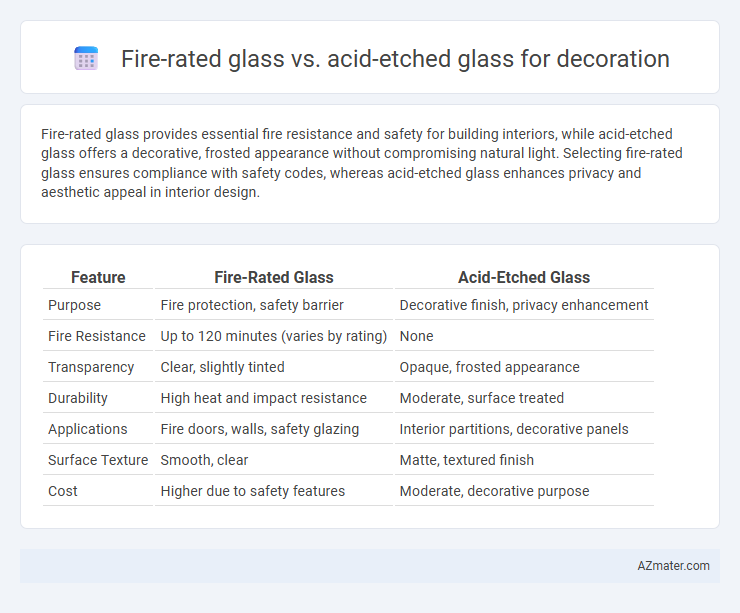Fire-rated glass provides essential fire resistance and safety for building interiors, while acid-etched glass offers a decorative, frosted appearance without compromising natural light. Selecting fire-rated glass ensures compliance with safety codes, whereas acid-etched glass enhances privacy and aesthetic appeal in interior design.
Table of Comparison
| Feature | Fire-Rated Glass | Acid-Etched Glass |
|---|---|---|
| Purpose | Fire protection, safety barrier | Decorative finish, privacy enhancement |
| Fire Resistance | Up to 120 minutes (varies by rating) | None |
| Transparency | Clear, slightly tinted | Opaque, frosted appearance |
| Durability | High heat and impact resistance | Moderate, surface treated |
| Applications | Fire doors, walls, safety glazing | Interior partitions, decorative panels |
| Surface Texture | Smooth, clear | Matte, textured finish |
| Cost | Higher due to safety features | Moderate, decorative purpose |
Introduction to Decorative Glass Solutions
Fire-rated glass offers superior safety by resisting high temperatures and preventing fire spread, making it ideal for secure decorative applications in commercial and residential spaces. Acid-etched glass enhances aesthetic appeal through its frosted, translucent finish, providing privacy while allowing natural light to filter through. Combining both options allows designers to balance safety requirements with elegant visual effects in interior and exterior architectural projects.
What is Fire-Rated Glass?
Fire-rated glass is specially engineered to withstand high temperatures and prevent the spread of fire and smoke, making it essential for safety in commercial and residential buildings. It typically consists of multiple laminated layers with intumescent materials that expand when exposed to heat, maintaining the integrity of fire barriers. Unlike acid-etched glass, which is primarily used for aesthetic purposes with a frosted, textured surface, fire-rated glass balances decorative appeal with critical fire protection performance.
Understanding Acid-Etched Glass
Acid-etched glass features a frosted, matte finish created through chemical treatment, enhancing privacy and diffusing light while maintaining translucency, making it ideal for decorative applications. Unlike fire-rated glass, which prioritizes heat resistance and safety in fire emergencies, acid-etched glass is primarily valued for aesthetic texture and subtle light softening in interior designs. Its non-transparent surface ensures privacy without compromising natural illumination, suitable for offices, partitions, and decorative panels.
Key Differences Between Fire-Rated and Acid-Etched Glass
Fire-rated glass is specifically engineered to withstand high temperatures and prevent the spread of fire, making it essential for safety and building code compliance, while acid-etched glass is primarily designed for aesthetic purposes with a frosted, textured finish that diffuses light and enhances privacy. Fire-rated glass typically contains multiple layers including intumescent materials to provide fire resistance, whereas acid-etched glass involves a chemical treatment process to create its distinctive appearance without impacting structural integrity. The main functional distinction lies in fire-rated glass's performance in fire scenarios versus acid-etched glass's emphasis on decorative appeal and light diffusion.
Fire Safety: Performance and Standards
Fire-rated glass is engineered to withstand high temperatures and prevent the spread of flames and smoke, meeting stringent standards like UL 9 and NFPA 257 for fire safety performance. Acid-etched glass, while favored for its decorative frosted appearance, does not possess fire-resistant properties and fails to comply with fire safety regulations. Choosing fire-rated glass ensures compliance with building codes and provides essential protection in fire emergencies, making it the superior choice for safety-focused architectural applications.
Aesthetic Appeal and Customization Options
Fire-rated glass offers a sleek, modern aesthetic with options for clear, wired, or frosted finishes that enhance safety without compromising design, making it suitable for contemporary architectural features. Acid-etched glass provides a versatile matte texture with intricate patterns and designs customizable through sandblasting or chemical treatment, ideal for adding artistic and privacy elements to spaces. Both types allow tailored solutions, but acid-etched glass excels in detailed decorative customization, while fire-rated glass prioritizes safety with aesthetic flexibility.
Applications in Modern Interior Design
Fire-rated glass offers enhanced safety and compliance in commercial and residential spaces where fire protection is critical, such as office partitions, stair enclosures, and healthcare facilities. Acid-etched glass provides aesthetic appeal and privacy by diffusing light and eliminating glare, making it ideal for decorative walls, doors, and partitions in modern interiors. Combining fire-rated and acid-etched glass solutions allows designers to achieve both functional safety requirements and sophisticated visual effects in contemporary architectural projects.
Durability and Maintenance Considerations
Fire-rated glass offers superior durability due to its ability to withstand extreme temperatures and impacts, making it ideal for safety-focused decorative applications. Acid-etched glass, while aesthetically appealing with its matte finish, is more susceptible to scratches and requires regular cleaning to maintain its appearance. Maintenance of fire-rated glass involves periodic inspections to ensure integrity, whereas acid-etched glass demands gentle cleaning methods to preserve its textured surface.
Cost Comparison and Value Analysis
Fire-rated glass typically costs between $50 to $150 per square foot, reflecting its specialized construction for safety and compliance with fire codes, offering high value in commercial or high-risk residential settings. Acid-etched glass, priced around $30 to $70 per square foot, provides aesthetic appeal through frosted, textured finishes but lacks fire resistance, making it more suitable for decorative applications with lower safety demands. The value of fire-rated glass justifies its premium by combining design with protection, while acid-etched glass offers cost-effective visual enhancement without added safety features.
Choosing the Right Glass for Decorative Projects
Fire-rated glass offers enhanced safety by withstanding high temperatures, making it essential for decorative projects requiring fire protection without compromising aesthetics. Acid-etched glass provides a frosted, textured finish ideal for privacy and elegant design but lacks fire resistance. Selecting the right glass depends on balancing safety requirements with the desired decorative effect for the specific project.

Infographic: Fire-rated glass vs Acid-etched glass for Decoration
 azmater.com
azmater.com